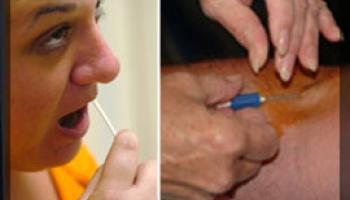Archival Notice
This is an archive page that is no longer being updated. It may contain outdated information and links may no longer function as originally intended.
Home | Glossary | Resources | Help | Contact Us | Course Map
A CODIS hit may provide probable cause for an arrest. The prosecutor should remember, however, that the CODIS hit is rarely admissible at trial, in part for chain of custody issues. Additionally, not bringing the cold hit before the jury avoids potential issues regarding databases of convicted persons and corresponding population statistics.
New or "fresh" reference samples need to be lawfully obtained from the suspect so that confirmatory typing may be done. Most forensic labs have protocols which require a suspect's sample be obtained either by written consent or by warrant or other court order. In many states, a search warrant can only be executed and served within the jurisdiction where the suspect is located. If the suspect resides outside the jurisdiction, the prosecutor may need to assist the lead investigating officer in making certain the warrant is properly executed in the jurisdiction in which the suspect resides.
Once the "fresh reference samples" have been obtained, they, together with the evidence collected (including the victim's standards, where applicable), need to be
transported to the lab for confirmatory typing. This process can take weeks before the test results and lab reports are finalized. If the suspect is already in custody on other charges, it is preferable to make the arrest on the new charges and commence the prosecution after the confirmatory typing is completed. However, if the suspect is at large, an arrest may be needed before the confirmatory typing can begin. In this case, it is advisable to obtain the suspect's reference samples at or as close to the time of arraignment as possible.
Additional Online Courses
- What Every First Responding Officer Should Know About DNA Evidence
- Collecting DNA Evidence at Property Crime Scenes
- DNA – A Prosecutor’s Practice Notebook
- Crime Scene and DNA Basics
- Laboratory Safety Programs
- DNA Amplification
- Population Genetics and Statistics
- Non-STR DNA Markers: SNPs, Y-STRs, LCN and mtDNA
- Firearms Examiner Training
- Forensic DNA Education for Law Enforcement Decisionmakers
- What Every Investigator and Evidence Technician Should Know About DNA Evidence
- Principles of Forensic DNA for Officers of the Court
- Law 101: Legal Guide for the Forensic Expert
- Laboratory Orientation and Testing of Body Fluids and Tissues
- DNA Extraction and Quantitation
- STR Data Analysis and Interpretation
- Communication Skills, Report Writing, and Courtroom Testimony
- Español for Law Enforcement
- Amplified DNA Product Separation for Forensic Analysts


